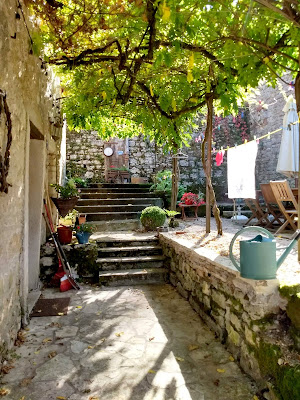I’m still on my own personal spring break right now, doing my best to rest and slow down. Here is a post from 2014 that shows this is an ongoing issue for me. Maybe for you, too?
“Slowness is an option for everyone on the planet, not just a privilege reserved for the very wise or very young or very rich. All of us can decide (and the phrase is a potent one)
to take our time.”
—Christian McEwen, World Enough and Time
For the past few weeks, I’ve been experimenting with deliberately slowing down my actions. I’ve been surprised by how many times I catch myself rushing, as opposed to simply moving efficiently and deliberately. When I take the dog’s medications out of the cupboard, when I get out of the car to go inside, when I unload the dishwasher—I feel an internal push to hurry. (Gretchen Rubin describes this feeling perfectly in Happier at Home: “I always have the feeling that I should be working. I always feel pressed for time, as if someone were shoving a pistol in my back and muttering ‘Move, move, move!’”) I’m already aware that when I hurry I break things and hurt myself, and I really don’t need to hurry every minute of every day, so what gives?
It’s at least partly the familiar and eternal battle between doing and being. No matter how hard I try, it seems that I can’t shake the feeling that if I’m not doing something (or hurrying on to the next something) then I’m not worthy. No matter how much I streamline my do-do list, there’s always more to do than I’ll ever be able to accomplish. Hurry has become a habit. One I’m determined to break.
Even with my new focus on not hurrying, and even though I’ve written several blog posts about the concepts of doing less and slowing down (see “Do Less in More Time” and “One Less Thing,” for example), I still struggle to follow my own advice. Take last Thursday. First, while driving home from the grocery store, I stopped too quickly at a stop sign, spilling my coffee into the cup holder and down the center console. After I cleaned that up and got the groceries unloaded, instead of just chilling for a few minutes, I got caught up on the computer and was late leaving for yoga class. I barely had time to take off my shoes, drop my keys and roll out my mat before it started. I felt flustered, distracted and off balance for at least half the class and the quality of my poses suffered. After lunch, while on the way to run an errand with no timetable, I realized I had a death grip on the steering wheel as I tried to hit every traffic light just right.
Slow down there, girl.
After that, I started reminding myself of a principle Natural Horsemanship practitioner Pat Parelli often refers to: Go slower to go faster. Here’s an example in action: that five seconds I saved by hurrying to go in the house is more than eaten up by the time it takes me to retrieve the mail from beneath the car where I just dropped it. If I’d taken my time in the first place, I’d already be inside (in the air conditioning) rather than crawling on the floor of the garage.
When I remember to slow down, time does seem to lengthen. I’m able to move more smoothly from one thing to another without feeling internal pressure goading me on. So I’ll continue to pay attention to the speed at which I move. Keep saying no to busy work and rushing. Value the time and space between activities as much as the activities themselves. Seek out activities with a slower pace. And I’ll keep working on taking my time.
What makes you feel rushed? How do you slow down?
 |
| No rushing allowed |

















































.jpg)


